Community
Artifact Dance Goes Back in Time for The Grand Parlor
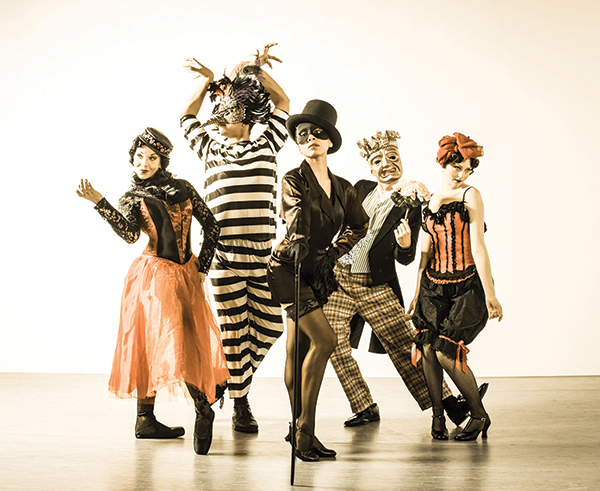
Artifact dancers Claire Hancock, Julian Johnson, Cindy Cantos, Bill Patterson, Alissa Dill. photo by Ed Flores
Tucson’s dance world has been blessed with a number of remarkable groups over the past 30 years. We’ve seen companies who have delivered traditional, timeless works like clockwork, as well as groups who have pushed the performance envelope with their content and audience experience. In the art world today, both locally and nationally, collaboration is the key to engaging and entrancing an audience, and the Tucson-based Artifact Dance Project is clearly both an innovator and practitioner par none. The group’s March performance at the Tucson Scottish Rite Cathedral is entitled “The Grand Parlor,” and it has all of Artifact’s signature elements on display in a smorgasbord for the senses.
According to Artifact’s Managing Director and Co-Artistic Director Ashley Bowman, the performance is envisioned as an “Americana Vaudeville” evening of years past. The wide variety of acts, includes modern dance, tap, a contortionist, a little clown work and even homage to Noah’s ark. As with all Artifact Dance performances, music is a key element to the experience. Ben Nisbet has again created the sonic portion of the evening, which will be performed live during the evening. Works include classical standards such as; Saint Saen’s Danse Macabre and Rossini’s Barber of Seville overture along with works by Dvorak, Tchaikovsky, Schubert and Gershwin. Musicians for the evening include; Derek Granger, Ken Marrs, Mary Turcotte and Samantha Bounkeua. A ringmaster, Artifact Dance company member dancer Cindy Cantos, will guide the intimate audience on their journey through the evening’s 14 vignettes, which will also feature a short intermission. The show is both family friendly and adult friendly with cocktails available to complete the cabaret experience for those of appropriate age.
Of special note is the location for the “Parlor” performances, in the Tucson Scottish Rite Cathedral’s Grand Parlor. The building, listed on the National Register of Places, recently celebrated its 100th anniversary and is a local landmark that would have hosted events such as this in the past. The local Masonic Order still uses the facility for functions, but recently it has been used more and more by the community for special events, largely due to its vintage character and downtown location. Several of last year’s Tucson Fashion Week runway shows made use of the space very effectively, and the Artifact’s Grand Parlor performances will again transform the space into a unique location for arts performances. With such a wide variety of components to the show, it’s hard for Bowman to pick a favorite section. One has to imagine that the entire presentation of a modern dance company’s interpretation of the American Vaudeville performance style in a century-old building, will be something to remember for a long time. This is sure to be one of the performing arts seasons highlights.
The Grand Parlor, by Artifact Dance Project takes place March 18-19-20 at the Tucson Scottish Rite Cathedral, located at 160 S. Scott Ave. Tickets are $25 or $20 for students and are available in advance or at the door.
Get Around on the Free GemRide Shuttle
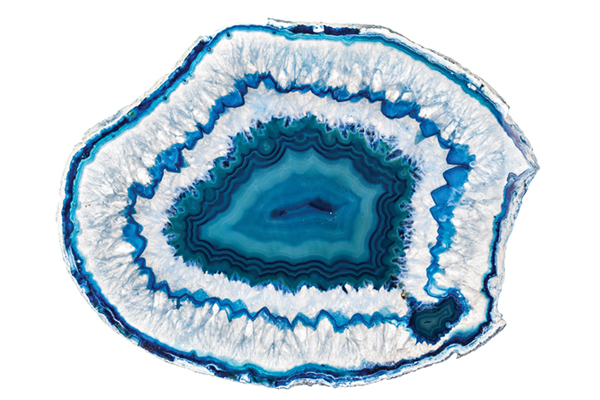 Park your car and get on the free GemRide shuttles to get around the Tucson Gem, Mineral & Fossil Showcase. The free GemRide shuttles will run daily through Sunday, February 14, on three routes:
Park your car and get on the free GemRide shuttles to get around the Tucson Gem, Mineral & Fossil Showcase. The free GemRide shuttles will run daily through Sunday, February 14, on three routes:
Downtown Gem Loop
8 a.m. to 7 p.m.,18 shows from 6th Street to 25th Street, including at the Tucson Convention Center.
Mineral & Fossil Loop
8 a.m. to 7 p.m., 15 shows between Downtown and Grant Road.
Kino Gem Loop
9:30 a.m. to 6:30 p.m., 9 shows at, south and east of Kino Sports Complex.
Free GemRide shuttles on a fourth route will run daily through Monday, February 8:
Bead Loop 9:30 a.m. to 6:30 p.m., 4 bead shows on Ajo Way, Alvernon Way, South 4th Avenue and Pennsylvania Street.
Park for $5 all day ($10 for RVs) at the Downtown West Hub, 700 W. Congress, where you can get on both the Downtown Gem Loop and the Mineral & Fossil Loop. Parking is free at the Tucson Expo Center, 3750 E. Irvington Road, where you can get on both the Kino Gem Loop and the Bead Loop.
Details at GemRide.com
The Gem Show Scene
 When talking about Tucson’s annual Gem, Mineral & Fossil Showcase, people who have been around a while will tell you that it’s changed, that it’s not what it used to be and that nothing is as cool as it was in the good old days. “For years I used to shop for people who live in town, “says Aspen Green, a long time Tucsonan; “people who did not want to be seen because they were too well known. They’d give me a list and $1,000 and I would know exactly where to go to find just the right piece of amethyst or rug or clothing or beads. I had passes to all the shows and I knew just where to get all the good stuff!
When talking about Tucson’s annual Gem, Mineral & Fossil Showcase, people who have been around a while will tell you that it’s changed, that it’s not what it used to be and that nothing is as cool as it was in the good old days. “For years I used to shop for people who live in town, “says Aspen Green, a long time Tucsonan; “people who did not want to be seen because they were too well known. They’d give me a list and $1,000 and I would know exactly where to go to find just the right piece of amethyst or rug or clothing or beads. I had passes to all the shows and I knew just where to get all the good stuff!
“But it’s changed,” she laments, “about five years ago when different shows started moving around town and the state started charging sales tax.” Now with a full time job at UA Presents, whose busiest season conflicts with The Show, annually held the first two weeks in February, Green has neither the time nor enthusiasm to go out and enjoy the show, much less work it.
But while this may be true for Green and others who have seen more than their fair share of Street Fairs, Tucson Meet Yourself and other annual events that may have lost their one time appeal, this is a two week extravaganza that consistently demands to be seen with fresh eyes. Aside from how vast and expansive it is, this is a time when literally hundreds of millions of dollars’ worth of precious stones, crystals, minerals and metals inundate our city. There are those in fact who will swear there is an actual shift in the vibrational space/time continuum. But its not just rocks and such as but also clothing, jewelry, fossils, glasswork, beads and beadwork of every conceivable nature, here to be bought, sold, traded, haggled over or simply admired. Add lots of music, parties, the marathon glassblowing competition and a cast of characters straight out of Central Casting including wholesale buyers, sellers, gemologists, jewelers, import/export people, musicians, hippies and ex-hippies now masking as straight laced business types. It’s a wonder no one has seen fit to make an indie movie of this scene.
“What makes it special are the people who come back every year.” So says Sirena Jan Allen who has worked a booth at the show for various out of town vendors for almost 20 years. Initially working for a seller of Peruvian clay and hand painted beads, she loved the opportunity to meet people from all over the world. “There is an excitement that builds,” she says that comes from being a part of so many different reunions taking place with folks who only get to see each other for these few days every year.
Actually, the Gem, Mineral & Fossil Showcase is a bit of a misnomer. A cursory search on Google will reveal a schedule that features no fewer than 40 different shows or expos spread throughout the city (tucsongemshows.net) . Some are strictly wholesale and some require official badges. But most are open to the public, with many housed in huge tented areas or spread across hotel rooms, suites and balconies.
Some of the better known hot beds of activity include what used to be known as the Holidome on Palo Verde and Irvington; the tents set up by TEP Park on Ajo and Country Club and of course the fortnight’s grand finale in the Tucson Convention Center, a high end show according to some, where there is also an admission charge.
Congress St., just west of downtown is also an area that usually houses a huge tented area. But it is the I-10 Frontage Road, running from Grant Rd. to just south of 22nd St., with all of its roadside motels, that provides a huge cornucopia of (for lack of a better word) stuff, for anyone interested in cruising the side of the highway on bicycle or foot with thousands of other bargain hunters, curiosity seekers and people watchers.
And speaking of the strip, at the very south end of the Frontage Road, just south of 22nd St. is the African Village. This is one of the true gems (pun intended) of the entire show. In what is normally a huge vacant dirt lot, this space is annually transformed into a place of drums and other instruments, masks, lanterns, necklaces, jewelry, clothing, furniture, etched glass and so much more with one vendor after the next representing a unique part of the African continent. This is truly a land of many cultures. For many who frequent the show, a trip to the African Village serves as an annual pilgrimage in and of itself.
And finally, at the other end of the strip by Grant Road, is the Gem and Jam Show (ticketfly.com) What began as a single night of music at a Fourth Ave. Club, has morphed from those humble beginnings into its current incarnation as a full fledged three day Festival complete with three day passes, hotel packages and other festival perks.
Alan, a wholesale buyer from North Carolina and one of those guys who could be from Central Casting, is a fitness buff and may spend half his time here bicycling into the Catalinas or even New Mexico’s Gila Wilderness. But he still remembers the time when he got to see a 50 karat chrome tourmaline and an emerald green garnet worth $300,000. “And everybody is a wheeler dealer,” he says with a wry smile. With so much to take in, what’s still not to like?
3 Resources to Help You Navigate This Weekend’s Open Studio Tour
The 2015 Tucson Fall Open Studio Tour takes place Saturday and Sunday, November 14 & 15, from 11am-5pm.
Over 180 Tucson artists open their studios to the public. Use any of the following resources to assist you on this self-guided tour:
1 – TPACOST.org – The most comprehensive guide to the tour, with listings by name and by area. Detailed google maps guide you to your destination with ease and the site is mobile friendly.
2 – Zocalo Magazine in print – If you haven’t already, grab a copy of Zocalo Magazine’s November edition, available at over 350 locations city-wide. Inside, you will find 12 pages dedicated to the tour with 180 artist listings and map locations. Extra copies of the magazine have been recently stocked DOWNTOWN, at Wood & Pulp (outside rack) at 439 N 6th Ave, SW corner of 6th St and 6th Ave; MIDTOWN at The Loft Cinema; EASTSIDE at Bookman’s Speedway (6230 E. Speedway) and in the FOOTHILLS at AJ’s Fine Foods (inside, near checkout) in the La Encantada shopping plaza.
3 – Zocalo Magazine online – Use the digital version of Zocalo Magazine (a replica of the print edition) OR browse the digital standalone version of the Open Studio Tour guide, here.

Remembering Together
The 2015 All Souls Procession Weekend
With thousands of more participants, a finale performance of grand proportions and epic new art and music installments, the All Souls Procession of 2015 is bigger and more impactful than ever before.
 What began in 1990 as a small gathering to celebrate the memories of deceased loved ones through performance art has now grown into the biggest celebration of its kind in the US, as the 26th annual All Souls Procession prepares to host over 150,000 participants to the storied festival. The highly edifying and cathartic event, organized by local non-profit organization Many Mouths One Stomach, will be taking place this year on Sunday, November 8th in Downtown Tucson.
What began in 1990 as a small gathering to celebrate the memories of deceased loved ones through performance art has now grown into the biggest celebration of its kind in the US, as the 26th annual All Souls Procession prepares to host over 150,000 participants to the storied festival. The highly edifying and cathartic event, organized by local non-profit organization Many Mouths One Stomach, will be taking place this year on Sunday, November 8th in Downtown Tucson.
The All Souls Procession is a celebration of death and life that coincides with Mexico’s Dia De Los Muertos in honoring and remembering loved ones who have passed on. Masses of Tucsonans and people from all over the world will gather to march in the streets with painted faces, masks and festive garb to honor the lost souls by bearing blown up photographs, posters and letters commemorating them. The finale that will be taking place next door to Mercado San Agustin, where live music, fire dancers, and performance artists will entertain the crowd before the urn that is filled with letters and messages to deceased loved ones will be raised and ignited high above the crowd in a moment of exulting release.
“The one thing I see lacking in our society is how we honor our dead, at least in Western civilization. Most people don’t take the time or put the intention forth into slowing down and honoring our lost loved ones and celebrating their lives,” says event organizer and Director of Flam Chen Paul Weir. “The goal is that this experience is authentic and real and taken seriously. We want people to let go and feel supported and connected. Everyone is a participant in this. Everyone is invited into the streets to be a part of this and to feel part of something much bigger as a collective. Especially in today’s society, this is a very visceral and authentic experience and there’s a lot of value on each and every person involved.”
This year procession route is the same as last year’s event, as it starts downtown on 6th Ave and 6th street near the underpass. There will be a DJ playing there and sending out dedications and the Hungry Ghosts busking crew will be roaming around to collect donations. People will start culminating at 4:00pm and then procession will begin around 6:30pm. The march is a two-mile route from the underpass to Alameda to Congress Street and then underneath I-10 to the finale location at San Agustin.
This year’s event carries a specific theme to honor those who are “unmournable” due to unfortunate circumstances before they passed. “The theme this year that we’re working with is UnMournable Bodies, which includes everyone from criminals to drug addicts to people who were enemies of the state and people who are caught in the crossfire of war. A lot of people die nameless when families get decimated. A lot of people are forgotten because of one or two poor choices or actions they made while living. So our finale ceremony this year pays homage to those people,” says Weir.
As the event continues to grow to mass proportions, it increasingly gains attention from such outlets as The New York Times, Huffington Post, CNN and many other news organizations. Because of this, the number of people who travel from all over the world to be a part of it has also steadily been increasing, which is great for the event itself, and for the city of Tucson as a whole. Those attending the event for the first time will undoubtedly be in awe, but it’s important to remember the sole purpose at the heart of the festival.
“People coming for the first time should definitely put something in the urn for someone they’re trying to remember to really make that walk and experience meaningful to them,” says Weir. “It is beautiful and it is a spectacle, but everyone walking in that parade is walking for somebody. Hold that in your heart and understand that it’s a public ritual and you’re here to participate in it. It’s really that memory and that intention that is the most valuable part of the experience. The show at the finale is beautiful and we really try to push ourselves in creating something from an authentic place of expression. But in the end, it’s about the urn burning and the flames consuming those memories and sending them out to the universe.”
To prepare for an event of this magnitude, MMOS has to fundraise and plan ahead accordingly to accommodate for the annual growth. The board has already started planning for 2016 and 2017’s events in order to stay within their tight budget. While the city recently gave them a grant for $10,000 a year, the event typically costs more than $150,000 to put on, so donations and support is greatly appreciated and essential for the livelihood of future year’s processions.
“Donations are so meaningful to us because it’s a free event to attend and you can come participate at the deepest of levels for absolutely nothing. We don’t pollute the space with advertising or endorsers at all, because we take it very seriously that this is to honor our loved ones, so we turn down that kind of thing. We’re a non-profit and mostly artists created every year. Our board and staff are primarily volunteers and the directors of the parade that do the long, hard work get paid just a few cents per hour. So when you see the Hungry Ghosts busking crew out during the event, please remember that even a dollar or two per person goes an extremely long way for us.”
For those who are unable to make it to the event this year, or if you don’t like big crowds, fear not, because the final ceremony will be live streaming at www.VisitTucson.org. Check the website up to 48-hours before the event to find the link, which will include video, audio and a commentator from 6:30pm to 9:30pm on November 8th. And if you do make it to the procession, make sure to get there early, bring the whole family, and get ready for one of the greatest experiences of your lives, and all in celebrating and honoring the spirits of the dead.
Complete details on the 2015 All Souls Procession can be found at allsoulsprocession.org

Tucson’s Inaugural 10 West Festival
 An Innovative Way to Drive Economic Development
An Innovative Way to Drive Economic Development
This month, Tucson creators and entrepreneurs come together for the first ever “10West Festival,” a new and innovative approach to fostering a creative and technological environment in Tucson, with the goal of attracting and retaining talent in Southern Arizona.
To learn more about the festival, Zócalo reached out to Greg Teesdale, Executive Director of 10West. In addition to 10West, Greg delivers curriculum to Startup Tucson accelerator and incubator programs as well as provides senior executive leadership to Startup Tucson. He is a member of the Desert Angels and also the Chief Financial Officer of Tempronics, a local growth stage technology company and a Desert Angels portfolio company.
Z: Please tell us about 10West and what you hope to accomplish during this inaugural event.
GT: Central to our mission at Startup Tucson is driving economic development in southern Arizona by fostering the entrepreneurial ecosystem, creating an environment where technologist and innovators can develop their ideas into real businesses and hold events, like 10West, that reflect these goals.
We describe 10West as the 20-40 year old demographic, the streetcar line geographic and the October 18-24 chronologic. This is the foundation year for an event that will ultimately be identified with Tucson and Southern Arizona on an international level.
The biggest challenge in this inaugural year has been gaining widespread recognition and endorsement of the event. The most important measure of success this year will be in attendance and we’re shooting a combined 5,000 – 10,000 people across all the events. Thinking long-term the true test will be how well we attract and retain talent in Southern Arizona.
Z: Can you describe the three organizational tracks the festival is focused on, why they were identified as such, and their importance to our region?
GT: 10West has been shaped to address the long-term goal of attracting and retaining talent in southern Arizona. When one believes that Southern Arizona is the place to achieve their desired life-work balance they will build careers and chase their entrepreneurial dreams here. The 10West technology track features workshops, panels and talks on cutting edge topics like 3D printing, virtual reality and the internet of things while the entrepreneurship track has sessions on building a company, access to capital and the many skills essential to every entrepreneurs’ toolbox. The 10West creative track addresses the live part of live-work with network mixers, music and entertainment as well as programming on the business of entertainment. Combined, these events are intended to attract the demographic that will be deciding their future.
Z: How is Tucson or Southern Arizona different from other regions in terms of our innovative and creative environment? What sets us apart?
GT: Southern Arizona has a number of features – a great university with a technology transfer agenda, a vibrant arts district, formation capital and, of course, the weather – that are important factors in attracting and retaining businesses and talent. The business community has to continue to get better at leveraging these features. The one thing that is unique to southern Arizona is the proximity to Mexico. There are great cross-border things happening and I’m seeing a noticeable up-tick in those activities. You’ll hear this theme echoed in the words and initiatives being promoted by Ricardo Pineda at the Mexican Consulate, Sandra Watson at the Arizona Commerce Authority and Denny Minano at Sun Corridor. It is no coincidence that these organizations are active supporters of 10West.
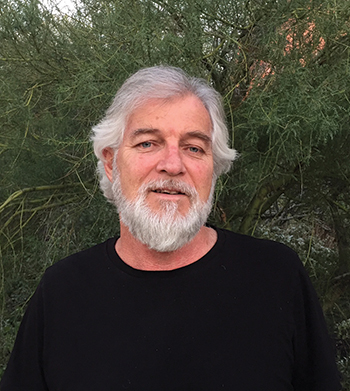
Greg Teesdale, 10West
Z: What is it going to take to jumpstart a Tucson economic boon, centered around technology, innovation, and creativity?
GT: A common saying in the national startup scene is that you have to take a twenty-year view and every day we start a new twenty years. While there’s great appeal to the idea of a magic bullet that will “jump start” economic development, success or more likely defined by a long list of small wins. We’re seeing those kind of small wins every day. And it takes the cooperation and participation of the collective stakeholders to keep these wins coming.
Z: How did 10West come about? What was the inspiration behind the creation of this festival?
GT: There are two key events in 10West that are the foundation of 10West. IdeaFunding was founded 19 years ago by Larry Hecker, a local attorney and active member of the business community. The Desert Angels, the local angel investor group, is the 3rd most active angel group in the US and the host of the Southwest Regional Angel Capital Conference. The organizing groups around these events felt there was an opportunity to leverage these events into something bigger and broader.
Last February we kicked this thing off at the Startup Tucson offices. We didn’t have a name, a mission, a logo or a website. The themes (technology, entrepreneurship, creative class) and definitions (demographics, geographic, chronologic) were all decided early on and we went from there.
Z: What are some of the highlights of the event?
GT: If we’ve done this right the highlight of the event will be different for everybody. It’s important to us that 10West be viewed in its entirety and not defined by any individual series of events. Even the events that get the best attendance may not be the most important in the long run. Having said that, the 19th year of IdeaFunding has to stand out. Larry Hecker’s vision continues to inspire. The technology and entrepreneur workshops and panels are at the heart of the mission. The Connected Communities Forum on Monday represents the confluence of technology and public infrastructure and will give us insights into how the Tucson of the future will look and feel.
Z: How is 10West being funded?
GT: 10West is being funded by a variety of financial sponsors from the community including the Arizona Commerce Authority, Research Corporation for Science Advancement, New York Life, the Desert Angels and many others. In addition we are receiving in-kind sponsorships from our partner organizations such as Hotel Congress, Rialto Theatre, Tucson Museum of Art, Connect Coworking and many others. Finally we have a number of media sponsors including this magazine, Clear Channel Outdoors, Arizona Daily Star, AZ Bilingual and many others.
Z: What are your plans for subsequent festivals?
GT: During 2015 we have answered the question “What is 10West?” We intend to build on name recognition and the goodwill of all of those involved to grow and broaden our reach. Over time we expect to grow regionally, nationally and internationally. We’ve engaged the Hispanic community and expect those connections to draw attendance from Sonora and points south. There are other legacy October events that may be brought under the 10West umbrella provided they fit the mission of the festival. 10West 2016 is scheduled for October 16-22.
Z: Anything else you would like to add?
GT: There is a lot of support for 10West but, more importantly, there’s even more support for the things that 10West represents.
10West takes place in Downtown Tucson, October 18-24th. For information, including a complete schedule of events, please visit www.10west.co
Firebird III GM Concept Car
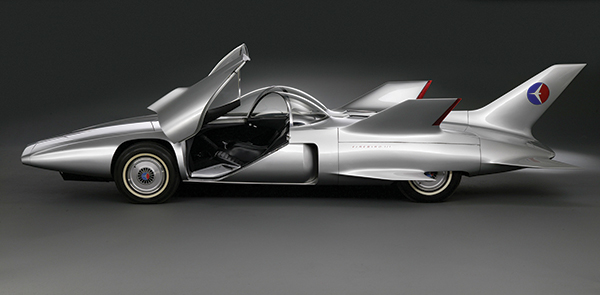
photos: Courtesy GM Media Archives
With its tailfins, double bubble canopy and air brakes disguised in its body, the Firebird III is space-age in the extreme. But it’s not just its Jetsons-meets-Batman style that makes it special.
“Most concept cars were just fiberglass dummies and didn’t have parts that really worked. This was the ultimate dream car or show car and it was also a research car,” says Jim Ewen, one of two designers of the Firebird III who will talk about it during Tucson Modernism Week while the car is on display at MOCA, the weekend of October 3rd.
 The Firebird III, built in 1958, is powered by a gas turbine engine as well as a two-cylinder gasoline engine for the accessories. A two-seater with a double bubble canopy, it has a joystick instead of a steering wheel and a titanium skin. Like GM’s other concept cars, it was inspired largely by fighter aircraft.
The Firebird III, built in 1958, is powered by a gas turbine engine as well as a two-cylinder gasoline engine for the accessories. A two-seater with a double bubble canopy, it has a joystick instead of a steering wheel and a titanium skin. Like GM’s other concept cars, it was inspired largely by fighter aircraft.
 Ewen, now living in Tucson, was brought in to develop the wheels, interior and instrument panel. He says the design team was convinced some of their concepts – particularly the gas turbine engine – would one day be adopted by every car manufacturer. “We often talked back in the 1950s about how the year 2000 would be the ultimate year [in car design],” he says. But mainstream design proved to be much slower than they anticipated.
Ewen, now living in Tucson, was brought in to develop the wheels, interior and instrument panel. He says the design team was convinced some of their concepts – particularly the gas turbine engine – would one day be adopted by every car manufacturer. “We often talked back in the 1950s about how the year 2000 would be the ultimate year [in car design],” he says. But mainstream design proved to be much slower than they anticipated.
As for Ewen, his own car choice is far more subtle. Rather than vintage cars, he says he prefers to get around in something a little more reliable. Currently that’s a Chevy Malibu.
For tickets and a complete schedule of Tucson Modernism Week happenings, please visit TucsonMod.com
Tucson Modernism Week

Photo: On Saturday, October 10, 5pm, join Architect Dino Sakellar (son of Nicholas Sakellar) for an exploration of the life and work of one of Tucson’s iconic mid-century modern architects. The son of Greek emigrants Nicholas and his bride, Phyllis, moved to Tucson soon after World War Two. Over his 50 years of practice he created many of Tucson’s most beautiful buildings. He is one of three architects credited with bringing modern architecture to Tucson.
Exploring Tucson’s Mid-century Design Heritage
After four years, jam-packed schedules and a slew of innovative lectures and events, you’d think the organizers of Tucson Modernism Week might start running out of ideas.
Not so. This year’s Tucson Modernism Week is busier than ever, the line-up arguably its most impressive to date.
That’s due in large part to the small army of volunteers behind the nine-day event. And it’s due in equally large part to the stories that abound here in Tucson, says Demion Clinco, Chief Executive Officer of the Tucson Historic Preservation Foundation, which organizes Tucson Modernism Week.
“I think that Tucson was definitely an epicenter of design in Arizona and regionally and in some ways nationally and we don’t give our community credit for that,” says Clinco. Added to that is the fact that retirees who settle here bring with them their own “incredible” stories, he says.
In fact, the more Clinco and his team digs, the more fascinating tales of mid-20th-century Tucson it uncovers. Some of those stories take longer to emerge than others, however.

1950s western wear dresses by Tucson based Dolores Gonzales (Dolores Resort Wear), a special exhibit of Tucson Modernism Week. Image courtesy of the Dolores Gonzales Family Collection.
Clinco first spotted the 1950s dresses of fashion designer Delores Gonzales in archive materials more than a year ago. It took many months and some detective work to locate her remaining family, now living in Colorado and California. That set in motion the creation of a fashion exhibition of Gonzales’ western wear, to take place in the lobby of the Tucson Convention Center on October 3rd and 4th.
Delores Gonzales was born in Sonora, Mexico in 1907. In 1914, at the age of 7, she moved with her family from Agua Prieta to Douglas, Arizona. The story goes that a bullet from a Pancho Villa raid had landed on Delores’ pillow. Her father said “Enough” and moved the family over the border. Gonzales learned her sewing skills from her mother Beatrice and honed them in Los Angeles where she was a pattern cutter. Bad asthma forced her to return to Tucson where she owned a factory and a store.
“She was quite well known in Tucson and societal circles,” says Bob Gonzales, Delores’ younger son, who with his brother Leo used to roll braid and rick rack in the factory as a child.
She was also influential in the fashion world. “Cele Peterson credited her as being a major component of the whole movement of patio and western dresses,” says Clinco. This “Tucsonan chic” style – which incorporated the colors and Native American influences of the southwest – was picked up by national department stores. Says Clinco: “There’s no one person who you can credit but [Delores] comes as close as you can get.”
“I think that it’s overdue,” says Dolores’ daughter-in-law Karyl Gonzales of the Tucson Modernism Week exhibit. “She more than won any accolade anyone ever gave her.” Karyl, who will attend the event, remembers Dolores as a “party girl, party giver and party goer.” She first set eyes on her future mother-in-law at a function at the Pioneer Hotel on Stone Avenue. “She had white hair pulled back in a bun. She was wearing a black gown. I thought she was the most beautiful woman I had ever seen,” says Karyl.
Karyl married Dolores’ son Leo (known as Lee) and she and Dolores bonded over fashion; Karyl studied theatre at the University of Arizona and went on to work in costuming. Karyl and Lee’s daughter Lisa Marie Gonzales – whose childhood wardrobe was filled with outfits Dolores made just for her – carries on the fashion legacy. Lisa Marie now owns the fashion line DCC Diversified Clothing Company in California.
Fashion is a strong theme of this year’s Tucson Modernism Week. Ted DeGrazia’s textile designs will be on show at the DeGrazia Gallery in the Sun, while the closing party is a 1965 fashion show and silent disco at the 1965-built Murphy Wilmot Library.
Other Tucson Modernism Week highlights include: a furniture and home goods expo at the Tucson Convention Center; a mid-century modern home tour featuring buildings by Arthur Brown, Louis Coon, Nicholas Sakellar and William and Sylvia Wilde (and special lectures on architects Nicolas Sakellar and William and Sylvia Wilde); and the annual vintage trailer show.
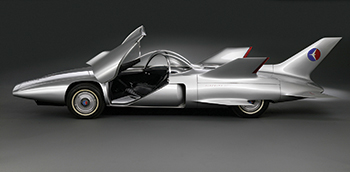
Firebird III GM Concept Car. Image courtesy GM Media Archives
One of the stand-out events will take place at MOCA Tucson: the arrival of the Firebird III [see sidebar]. This futuristic concept car was developed by General Motors in the 1950s as part of a series of car designs that were never intended for production, but rather to showcase just how far GM could go with its technology and design.
The car barely leaves its home at the General Motors Heritage Center in Sterling Heights, Michigan. On October 3rd, thanks to a collaboration between Tucson Modernism Week, the General Motors Heritage Center and insurance firm AIG, it will be on display for one weekend only at MOCA. Also present will be two of its designers, Norm James and Tucsonan Jim Ewen – reunited for the first time in more than 50 years.
The significance of the Firebird’s journey to Tucson isn’t lost on Thom Sherwood, a local Pontiac enthusiast and volunteer for Tucson Modernism Week. “It’s as if someone were to ask the Louvre in Paris to send the Mona Lisa to a backyard barbecue in Podunk, Arkansas. It’s a testament to the respect that GM feels towards its legacy and their designers, that it is undertaking to get the car shipped just for the weekend,” says Sherwood, who as well as moderating the Firebird III lecture, is overseeing a show of vintage “finned” cars outside the MOCA building on the same day.
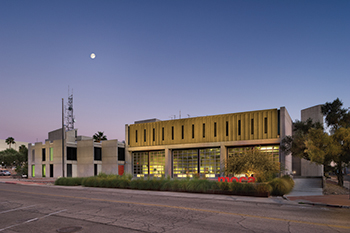
On Saturday, October 10, 3pm, join Demion Clinco for a look at the Architectural Work of William and Sylvia Wilde, pioneers of Modern architecture in Tucson, and designers of Tucson Police & Fire Departments, built in 1974. Photo by Garardine Vargas
Fun and fins aside, the organizers of Tucson Modernism Week hope their annual event does more than entertain. Its mission is “to educate the community” about the mid-century period and its renaissance, says Clinco. Volunteers try hard to hold their events in mid-century modern spaces. Architects who did influential work here in the middle of last century, but are not widely recognized for it, are celebrated. Clinco says that since Tucson Modernism Week began he sees the Tucson community taking more notice of the city’s mid-century buildings – some of which are hidden in strip malls. “Three years ago we didn’t see that happening. That makes me really thrilled. I’m confident people will be a little bit more conscious about mid mod design and not just cover it up with stucco.”
Last year’s Tucson Modernism Week pulled in 4,000 to 5,000 people, says Clinco, up from 3,000 the previous year. He reports ticket sales from the East Coast, Texas and even London. So why all the interest in the middle of the last century?
For one thing it was an exciting time in design, says Alan Hess, a Los Angeles historian, Tucson Modernism Week speaker and author of Googie Redux: Ultramodern Roadside Architecture. “The mid century period of the 20th century was a time of experiment and really talented architects [who moved] in a lot of different directions. The sunbelt generally was booming, people were moving there, there was development going on that attracted architects,” says Hess, whose lecture Modernism’s Back takes place at MOCA on October 3rd.
In the Arizona desert in particular, architecture was also functional, he says.“Modern architecture was about solving a problem. It was very very practical, especially when you were building a house in the desert and you have the sun coming into the house, the heat, the soil. All these things shaped the house.”
Luckily for Tucson and its mid century heritage, the Mad Men era is, quite simply, in vogue. Says Hess: “Every architecture style goes through its cycle. It’s new and then it gets to become old fashioned. It might get torn down, it gets rediscovered. It might take 30 to 50 years and it’s re-appreciated. This is just modernism’s time.”
For tickets and a complete schedule of Tucson Modernism Week happenings, please visit TucsonMod.com

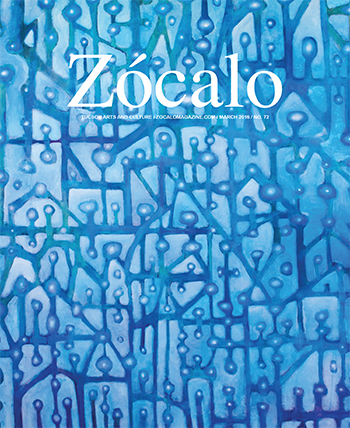
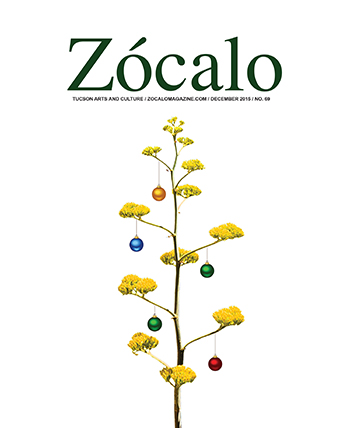




Also find us on...